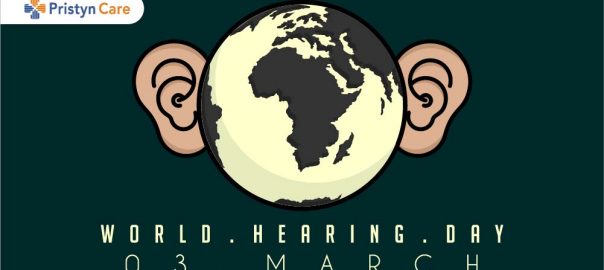![]() Views: 301
Views: 301
Tympanoplasty (or Eardrum surgery)
Dedicated Support at Every Step!
Our Doctors are available 24 hours a day, 7 days a week to help you!
Tympanoplasty is a surgery to repair a hole in the eardrum, commonly known as a perforated eardrum. Normally, very small tears heal on their own but if a hole isn’t patching itself up, then the ENT surgeon will patch it using a tissue graft.
Table of Contents
What is an eardrum?
A tympanic membrane, commonly known as an eardrum, is a thin membrane that separates the outer ear front he middle ear. The sound waves are collected by the ear pinna/outer ear and cause the eardrum to vibrate. These vibrations are then transferred to the bones in the middle ear for amplification. If there is a tear in the eardrum, the sound waves are not collected and transmitted properly which makes it harder for a person to hear.
You can protect your eardrum by following the given tips:
- Get prompt and proper treatment for ear infections
- Protect your ear if you are expecting a pressure change, for example during a flight, scuba diving, etc.
- Keep foreign objects out of your year.
- Be careful while cleaning your ear. Do not use objects such as cotton swabs, paper clips, or hairpins as they can easily pierce the eardrum, especially in children.
- Guard your ears against loud or explosive noises.
- Wear protective earplugs or earmuffs if you are expecting a shock or trauma to your eardrums.
No Cost EMI, Hassle-free Insurance Approval
How should I choose a doctor for tympanoplasty?
Tympanoplasty is generally performed by an ENT specialist. While choosing an ENT specialist, you should consider the following factors:
- Qualification and experience of the ENT surgeon
- Patient testimonials from previous patients
- Success rate of the surgeon
- Clinic/hospital infrastructure being used by the surgeon
- Insurance acceptance
Get a second or third opinion if you want. Make sure you are comfortable with the doctor before finalizing your decision.
When is a tympanoplasty performed?
The most common causes for an eardrum perforation for which tympanoplasty is performed are:
- Middle ear infection (otitis media)
- Barotrauma, i.e., ear trauma due to sudden changes in the air pressure level around the ear, commonly in scuba diving, automobile accidents, etc.
- Loud sounds or blasts (acoustic trauma)
- Insertion of foreign objects in your ear, such as a cotton swab, hairpin, etc.
- Severe head trauma
If you’ve recently undergone any of the above and are experiencing symptoms such as pain, pus-drainage, hearing loss, ringing, loss of balance (vertigo), nausea, etc., then you may have a perforated eardrum and you should seek treatment.
If left untreated, a perforated eardrum can lead to a variety of complications such as chronic ear infections and middle ear cyst (cholesteatoma). These complications can eventually lead to permanent loss of hearing over time.

Which diagnostic tests are required before a tympanoplasty?
Diagnostic tests are very important for determining the extent of damage to the eardrum and its surrounding tissues. Based on the results of the diagnostic tests, the type of tympanoplasty and graft required is determined. Diagnostic tests performed before a tympanoplasty are:
- Lab examination: If there is any discharge from the ear, it has to be examined in a laboratory to find out the cause of the infection.
- Tuning fork evaluation: Tuning forks help diagnose hearing loss caused due to damage to the vibrating parts of the middle ear (eardrum and bones), damage to nerves in the ear, or both.
- Tympanometry: It is a device that can be inserted into the ear to find any changes in the air pressure in the ear to diagnose a perforated eardrum.
- Audiology exam: It includes a series of tests to evaluate hearing at different volumes and pitches in a soundproof booth to diagnose hearing loss.
How should one prepare for tympanoplasty surgery?
Tympanoplasty is an invasive surgery, so you should follow your surgeon’s instructions diligently. Inform your doctor about your medical history, including allergies. Smoking and tobacco usage can increase the chances of complications during the surgery, so you should stop that at least a few days before the surgery.
Do not wear any earrings, make-up, or deodorant during your surgery. Since the surgery is mostly performed under anesthesia, you will need to stop any food/drink intake at midnight before the surgery.
If your doctor is recommending that you stay at the hospital overnight, then you should prepare an overnight bag. You may have a little trouble hearing for a few days after the surgery, so you should prepare yourself for that.
How is a tympanoplasty performed?
The complete surgical procedure takes about 2-3 hrs. Once the anesthesia has taken effect, the surgeon will cut behind the ear to reach the ear canal. Then, the surgeon will fill the hole using a graft. If there is any damage to the ossicular bones, then a prosthetic will be inserted in their place at the same time. Once the procedure is done, the patient is moved to a recovery room for overnight observation.
What are the types of a tympanoplasty graft?
A tympanoplasty graft can be made of a variety of materials, organic or synthetic. Organic grafts can be made of the temporalis fascia, cartilage, perichondrium, periosteum, vein, fat, or skin.
Among these, a true temporalis fascia graft is the most preferred graft as it is extracted close to the surgical site and is easy to harvest. However, for revision surgeries, usually, cartilage grafts are preferred as they are stronger and more durable.
Synthetic or nonautologous grafts eliminate the difficulties of graft harvesting and facilitate consistent wound healing. They are preferred in cases of extensive trauma where there is ossicular damage.
How to improve recovery after a tympanoplasty?
After tympanoplasty, you can return to work within 1-2 weeks of the surgery, but complete recovery may take 2-3 months. A little bleeding and drainage are common for the first 3-5 days after the surgery. The stitches are normally removed a week after the surgery.
Following the surgery, you should follow the given tips to improve recovery:
- Avoid getting water in the ear. Clean the area near the surgical site with a dry cotton ball.
- Elevate your head using pillows to reduce swelling.
- Avoid heavy lifting, vigorous exercise, and contact sports for 2-3 weeks.
- You should not swim or fly without receiving approval from your doctor.
What are the potential risks of a tympanoplasty?
Tympanoplasty is a very safe procedure with a success rate of over 87% and does not usually lead to any complications. However, in rare cases, certain complications may occur, such as:
- Bleeding and infection
- Dizziness
- Failure of graft
- Failure to reverse hearing loss
- Ringing in the ears (tinnitus)
- Strange taste in the mouth
Since tympanoplasty is performed in such a small area, complications are next to nil, but f you have extreme pain or high fever after the surgery, then there may be a complication and you should consult your ENT doctor straight away.














